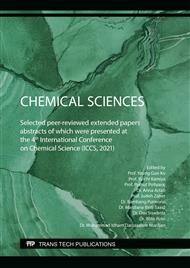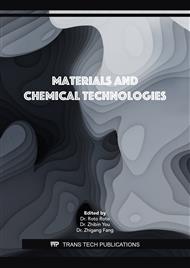[1]
K. Mikula, G. Izydorczyk, D. Skrzypczak, M. Mironiuk, K. Moustakas, A. Witek-Krowiak, K. Chojnacka, Controlled release micronutrient fertilizers for precision agriculture – A review, Sci. Total Environ. 712 (2020) 136365.
DOI: 10.1016/j.scitotenv.2019.136365
Google Scholar
[2]
T. Zhou, Y. Wang, S. Huang, Y. Zhao, Synthesis composite hydrogels from inorganic-organic hybrids based on leftover rice for environment-friendly controlled-release urea fertilizers, Sci. Total Environ. 615 (2018) 422–430.
DOI: 10.1016/j.scitotenv.2017.09.084
Google Scholar
[3]
L. Wu, M. Liu, R. Liang, Preparation and properties of a double-coated slow-release NPK compound fertilizer with superabsorbent and water-retention, Bioresour. Technol. 99 (2008) 547–554.
DOI: 10.1016/j.biortech.2006.12.027
Google Scholar
[4]
R. Gil-Ortiz, M.Á. Naranjo, A. Ruiz-Navarro, M. Caballero-Molada, S. Atares, C. García, O. Vicente, New eco-friendly polymeric-coated urea fertilizers enhanced crop yield in wheat, Agronomy 10 (2020) 438.
DOI: 10.3390/agronomy10030438
Google Scholar
[5]
M. Charoenchai, P. Prompinit, W. Kangwansupamonkon, L. Vayachuta, Bio-inspired surface structure for slow-release of urea fertilizer, J. Bionic. Eng. 17 (2020) 335–344.
DOI: 10.1007/s42235-020-0027-2
Google Scholar
[6]
B. Ishartono, S. Suyanta, I. Kartini, Effect of zeolite to clay ratios on the formation of zeolite-clay-white cement composite cylinder as an encapsulant of urea fertilizer, Key Eng. Mater. 884 (2021) 196–203.
DOI: 10.4028/www.scientific.net/kem.884.196
Google Scholar
[7]
I. Kartini, E.T. Lumbantobing, S. Suyanta, S. Sutarno, R. Adnan, Bioplastic composite of carboxymethyl cellulose/N-P-K fertilizer, Key Eng. Mater. 840 (2020) 156–161.
DOI: 10.4028/www.scientific.net/kem.840.156
Google Scholar
[8]
I. Kartini, K.H. Iskandar, C. Chotimah, E.S. Kunarti, R. Rochmadi, Effect of zeolite addition on the properties of bioplastic composites of carboxymethyl cellulose-urea, Mater. Sci. Forum 948 (2019) 175–180.
DOI: 10.4028/www.scientific.net/msf.948.175
Google Scholar
[9]
T. Abe, R. Takashima, T. Kamiya, C.P. Foong, K. Numata, D. Aoki, H. Otsuka, Plastics to fertilizers: Chemical recycling of a bio-based polycarbonate as a fertilizer source, Green Chem. 23 (2021) 9030–9037.
DOI: 10.1039/d1gc02327f
Google Scholar
[10]
H. Almasi, B. Ghanbarzadeh, A.A. Entezami, Physicochemical properties of starch–CMC–nanoclay biodegradable films, Int. J. Biol. Macromol. 46 (2010) 1–5.
DOI: 10.1016/j.ijbiomac.2009.10.001
Google Scholar
[11]
M. Rehakova, S. Čuvanová, M. Dzivak, J. Rimár, Z. Gaval'ova, Agricultural and agrochemical uses of natural zeolite of the clinoptilolite type, Curr. Opin. Solid State Mater. Sci. 8(6) (2004) 397–404.
DOI: 10.1016/j.cossms.2005.04.004
Google Scholar
[12]
D. Bhardwaj, M. Sharma, P. Sharma, R. Tomar, Synthesis and surfactant modification of clinoptilolite and montmorillonite for the removal of nitrate and preparation of slow-release nitrogen fertilizer, J. Hazard. Mater. 227-228 (2012) 292–300.
DOI: 10.1016/j.jhazmat.2012.05.058
Google Scholar
[13]
R.C. Bansal, M. Goyal, Activated Carbon Adsorption, 1st ed., CRC Press, Boca Raton, (2005).
Google Scholar
[14]
R.M.C. Viegas, A.S. Mestre, E. Mesquita, M. Machuqueiro, M.A. Andrade, A.P. Carvalho, M.J. Rosa, Key factors for activated carbon adsorption of pharmaceutical compounds from wastewaters: A multivariate modelling approach, Water 14 (2022) 166.
DOI: 10.3390/w14020166
Google Scholar
[15]
M. Manivannan, S. Rajendran, Investigation of inhibitive action of urea-Zn2+ system in the corrosion control of carbon steel in sea water, Int. J. Eng. Sci. Technol. 3 (2011) 8048–8060.
Google Scholar
[16]
E. Susilowati, I. Kartini, S.J. Santosa, Triyono, Effect of glycerol on mechanical and physical properties of silver-chitosan nanocomposite films, IOP Conf. Ser.: Mater. Sci. Eng. 107 (2016) 012041.
DOI: 10.1088/1757-899x/107/1/012041
Google Scholar
[17]
C.V. Prasad, B.Y. Swamy, H. Sudhakar, T. Sobharani, K. Sudhakar, M.C.S. Subha, K.C. Rao, Preparation and characterization of 4A zeolite-filled mixed matrix membranes for pervaporation dehydration of isopropyl alcohol, J. Appl. Polym. Sci. 121 (2011) 1521–1529.
DOI: 10.1002/app.33688
Google Scholar
[18]
A. Rahman, M. Park, S. Park, Current progress on the surface chemical modification of carbonaceous materials, Coatings 9 (2019) 103.
Google Scholar



